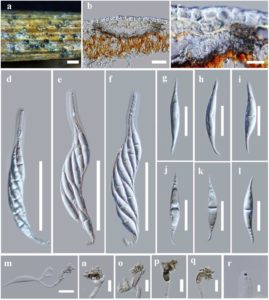Oxydothis palmicola Konta, B. Thongbai & K.D. Hyde, in Konta, Hongsanan, Tibpromma, Thongbai, Maharachchikumbura, Bahkali, Hyde & Boonmee, Mycosphere 7(9): 1438 (2016)
Index Fungorum number: IF 552540; Facesoffungi number: FoF 02705
Etymology – The specific epithet refers to the host substrate (palm).
Saprobic on dead leaves of Eleais guineensis Jacq. (Arecaceae). Sexual morph: Ascomata 111–195 μm diam. (x̅ = 166 μm diam., n = 40, up to 220 μm), solitary or aggregated, mostly solitary when young, becoming grouped at maturity, immersed, appearing as non-blistering areas through the host tissue, axis oblique or perpendicular to the host surface, with a central, 59–79 μm high × 182–263 μm diam. (x̅ = 67 × 215 μm, n = 5) papilla curving upwards and piercing the host cuticle. Peridium 18–34 μm (x̅ = 25 μm, n = 10), thick-walled outer cells merging with the host epidermal cells, comprising dark brown to black cells of textura angularis. Asci 138–145 × 15–20 μm (x̅ = 141 × 18 μm, n = 10), 8-spored, unitunicate, cylindrical-clavate, pedicellate, with a J+, wedge-shaped, subapical ring. Ascospores 51–53 × 6–8 μm (x̅ = 52 × 7 μm, n = 20), 2−4-seriate, fusiform, tapering gradually from the center to the ends, centrally 1-septate, not constricted at the septum, with pointed ends, hyaline, one large guttule at the center when immature, with one large guttules when in each cell mature, sometimes smaller near the ends, smooth-walled. Asexual morph: Undetermined. Appressoria 18–36 μm high × 12–16 μm diam. (x̅ = 23 ×14 μm, n = 10) solitary, hyaline to light brown, irregular in shape, thick-walled.
Culture characters– Ascospores germinating on MEA within 24 hours and germ tube developing appressoria. Colonies on MEA grey to olivaceous, white at the center, dense, with a fairly fluffy surfaces, hyphae, septate, branched, smooth-walled (Fig. 9 viz e).
Material examined– Thailand, SongKhla, Hatyai, on dead leaf Eleais guineensis (Arecaceae), 16 June 2015, B. Thongbai, SK01c (MFLU 15-2339, holotype, HKAS 95037, isotype); ex-type living culture, MFLUCC 15-0806.
Notes – Oxydothis palmicola resembles O. linospadicis J. Fröhl. & K.D. Hyde in ascospore shape, but differs in its lenticular ascomata and shape of ascospores. In our phylogenetic analysis, O. palmicola clusters with O. metroxylonicola. Oxydothis palmicola, however, differs from O. metroxylonicola; in its host, in having non-blistering ascomata, the shape of the ascospores, the J+, subapical ring and in culture characteristics. Both O. palmicola and O. metroxylonicola produce appressoria from germinating ascospores.

Fig 1. Oxydothis palmicola (holotype) a. Ascomata on host substrate. b. Section of ascoma. c. Peridium. d–f. Asci. g–l. Ascospores. m. Germinating ascospore. n–q. Appressoria. r. J+ reaction of apical ring in Melzer’s reagent. Scale bars: a = 500 μm, b = 50 μm, c = 20 μm, d–f = 50 μm, g–l = 20 μm, r = 5 μm.
